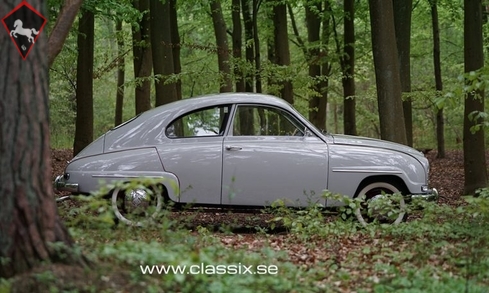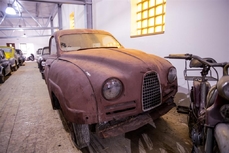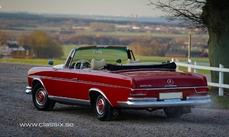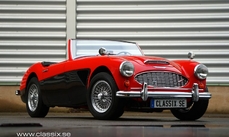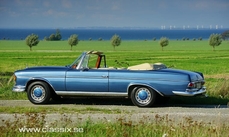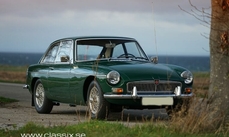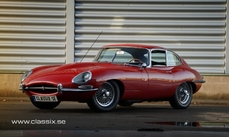Saab 93 F twostroke with front hanged doors in grey from 1960
General description :
The amazing SAAB 93 came in model 93B and 93F. The SAAB 93 model was produced between 1956 to 1960. The SAAB 93B means it had the doors hung from the back. And, in October 1959 came SAAB 93F which means it had the doors hung from the front. However, already in February 1960 came the next model called SAAB 96. Still with two stroke engines but lost a little of that first aerodynamic shape that the SAAB 92 and 93 cars had.
Exterior: The car was repainted in the original grey colour in 2017 when most of the restoration work was done on the car. Wheels painted in the correct colour and fitted with white wall tyres in correct size. New windscreen and new rubbers all around the car in screens and doors. Underneath has been cleaned and painted with black rust primer. It is a stunning looking SAAB 93 that puts a smile on the face of everyone who sees it driving by.
SAAB 93 for sale in Sweden with original interior
Interior: It is not easy to replicate the SAAB 93 interior since they used some special materials not easy to find today. But, in this car it is exactly like it was when the car left the factory in 1960. The extra textile carpet has been put on top to protect the original grey rubber mats. The instruments are beautiful and the knobs and switches are in excellent condition. In the glove box the original SAAB 93 owner’s manual and price list for repairs in your Philipsons dealership. In the trunk is the spare also fitted with a new tyre. The originally supplied head gasket kit and a can of SAAB original two stroke oil that were supplied with the SAAB cars.
Engine: The engine was rebuilt at 33,760km and today it has around 3,500km and is rolling on every sunny day in Sweden. All parts around the engine, such as starter, fan, charging system were also rebuilt during the restoration. Brakes are good and the 3-speed gearbox is easy to operate.
History: This is an exceedingly rare SAAB 93F and the model was only produced for 4 months. It changed hand many times over the years and full owner’s history comes with the documentation. It also comes with the very first registration document in original from Sweden. Owner’s manual, original tax stickers and some other very rare original SAAB items such as the spare head gasket, original tools etc.
This is most likely one of the best preserved with original parts SAAB 93 on the market. I did not do this restoration, it was done by one of the owners before me. It has been fully documented and I have great respect for the man that did the restoration. For the reason that he has preserved and brought back as many of the original parts as possible, instead of buying new and perhaps sometimes parts in less quality than the original. This is an incredibly special car to me, and any enthusiast of Swedish motor history.
Make:SAAB
Model:93
Km:35000
Transmission:3 speed
Manufactured in:Sweden
Horsepower/kw:35
Condition:2
1960 Saab 93 F twostroke with front hanged doors in grey from is listed for sale on ClassicDigest in Saxtorp by Classix by Schiebler Scandinavia AB for €1.
Car Facts
Car type : Car Make : Saab Model : 93 Model Version : F twostroke with front hanged doors in grey from Engine size : 0.0 Model Year : 1960 Sub type : Coupé Location : Saxtorp Vehicle Registration : Undefined
1 €
Seller Information
Classix by Schiebler Scandinavia AB
Classix by Schiebler Scandinavia AB
+46 707 658904
Classix by Schiebler Scandinavia AB
+46 707 658904
People who viewed this Saab 93 also viewed similar Saab listed at ClassicDigest
Other cars listed for sale by this dealer
About Saab
Saab, originally an acronym for Svenska Aeroplan Aktiebolaget (Swedish Aeroplane Company), began its journey as an aircraft manufacturer in 1937. Founded in Sweden, Saab's primary focus was on producing fighter planes and military aircraft. Over time, the company diversified its interests and ventured into automobile manufacturing, which eventually led to the creation of quirky yet innovative cars that stood out in the automotive industry.Fighter Plane Manufacturing:
Saab's history in the aviation industry was marked by its production of innovative fighter planes. One of its most iconic aircraft was the Saab 29 Tunnan, introduced in the early 1950s. The Tunnan was notable for its unique design, featuring a barrel-shaped fuselage, which earned it the nickname "The Flying Barrel." It was powered by a single jet engine and became Sweden's first domestically produced jet-powered fighter aircraft.
Following the success of the Tunnan, Saab continued to develop advanced military aircraft. The Saab 35 Draken, introduced in the late 1950s, was another milestone for the company. The Draken was a delta-winged interceptor known for its remarkable speed and distinctive double-delta wing configuration. Its innovative design allowed for excellent maneuverability and performance, making it a significant asset in Sweden's air defense arsenal for several decades.
Transition to Automobile Manufacturing:
In the late 1940s, Saab expanded its operations into the automotive industry. The company's first foray into car manufacturing resulted in the production of the Saab 92, which debuted in 1949. The Saab 92 was a compact and aerodynamic car powered by a two-cylinder, two-stroke engine. Its unconventional design, with a streamlined shape and front-wheel-drive layout, set it apart from other cars of its time.
As Saab continued to innovate, it introduced several notable models in the automotive market. The Saab 99, launched in the late 1960s, was a significant milestone for the company. It featured distinctive styling, including a wraparound windshield and a unique "hockey stick" profile, giving it a recognizable appearance. The Saab 99 also introduced technical advancements such as turbocharging, enhancing performance and fuel efficiency.
The evolution continued with the Saab 900, introduced in the late 1970s, which became one of the company's most iconic models. The Saab 900 was known for its robust build quality, innovative safety features, and unconventional design elements, including the signature wraparound windshield. It offered turbocharged engines and a versatile hatchback body style, catering to a niche market seeking individuality and practicality.
Technical Aspects and Quirks:
Saab cars were characterized by their technical innovations and unique features. Some of the standout technical aspects and quirks of Saab automobiles include:
Turbocharging: Saab was one of the pioneers in popularizing turbocharged engines in passenger cars, significantly enhancing power output without sacrificing fuel efficiency.
Safety Innovations: Saab prioritized safety and introduced various safety features, including reinforced passenger compartments, impact-absorbing structures, and advanced braking systems.
Aircraft-Inspired Design: The company incorporated design elements inspired by its aviation heritage, such as aerodynamic shapes, wraparound windshields, and unconventional styling cues.
Ergonomics and Practicality: Saab cars were known for their comfortable interiors, innovative ergonomics, and practical features like the ignition key placement between the front seats.
Quirkiness: Saab cars often featured unconventional design choices and solutions, appealing to a niche audience seeking something different from mainstream automobile offerings.
Saab's journey from a renowned fighter plane manufacturer to a builder of quirky yet innovative cars highlights its commitment to innovation, unique design, and technological advancement in both the aviation and automotive industries. Despite facing challenges and changes in ownership over the years, Saab's legacy endures through its distinct and unconventional approach to vehicle design and engineering.
